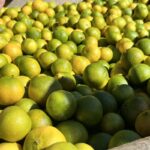Colombian citrus and its challenges

Colombia's citrus production is one of the country's main agricultural and economic drivers. In 2023, the country produced a total of 13.2 million tons of citrus fruit.
Colombia's Santander Department, located in the country's North-Central region, is the leader in citrus production and cultivated area. The region represents 24% of the country's total production, with 27,000 hectares planted.
Valle del Cauca comes in second, contributing 10% of Colombia’s total citrus production.
The Colombian Horticultural Association, Asohofrucol, reported that in 2023, most of Colombia's citrus production consisted of oranges (755,155 tons), followed by lemons (541,236 tons), Tahiti limes (316,338 tons), and mandarins (318,521 tons).
Due to its high level of citrus production, it makes sense that the third edition of the International Citrus Seminar—an event organized by Asohofrucol—took place in the country.
Marino Murillo, Secretary of Agriculture and Rural Development for the Government of Caldas, began the presentation by mentioning the country's efforts to coordinate a development plan for the citrus fruit sector to bring in younger generations to the agriculture business.
"We need to seek transformation of cultivation and marketing," he said. "We need the younger generation to be convinced that agriculture can be an efficient and profitable enterprise. Today, agriculture must be done through technology, with precision agriculture."
On the other hand, the technical secretary of the citrus chain at the Ministry of Agriculture and Rural Development, María Elena Noreña, added that, despite the lack of younger professionals, the sector is growing and expanding.
"These new market challenges bring and involve a process of traceability."
She also noted the new trends regarding consumption and agro-industrial management. Noreña explained that the Green Deal in the European Union—the main market for Colombian citrus fruits—" is showing us that the trend is to produce fruit sustainably."

Another challenge, Secretary Noreña explained, is prices.
"We’ve had seven months of declining prices, and we’re concerned because this is really a supply and demand issue," she said. "Every day more producers are planting Tahiti limes, and from the government, we are starting to build a process of trust and awareness, both with governmental and departmental institutions, to slow down the incentive to plant these types of fruit trees."
She added that it's important to seek sustainable alternatives for producers, "We are creating congestion in the markets, which leads to low prices and social issues that we are already starting to experience."
She explained that she's worried about the industry not reaching 110,000 hectares of citrus production, "we know we need to start finding marketing dynamics to ensure that all this production does not remain in the domestic market."
She believes this should be accompanied by productive models, such as "Tropical Agriculture."
HLB
Huanglongbing (HLB), also known as citrus greening, was mentioned during the seminar. The disease is recognized as the most destructive bacterial disease affecting the citrus industry worldwide
The technical secretary of the citrus chain at the Ministry of Agriculture and Rural Development mentioned that “the ICA, together with the Ministry, Asofrucol, and other organizations, is working on monitoring and eradicating the disease locally.”
Andrés Londoño, the president of Citricaldas’s board of directors, emphasized that the disease is the primary concern for producers in the region. "Although we do not have it at the moment, we know that is imminent arrival could destroy us.”
He explained that they have a competitive advantage over other regions in the country, and other countries, since Colombia is surrounded by forests, rivers, and mountains that act as natural barriers "which we should take advantage of."
He stressed that monitoring is the main tool for containing HLB. “We have a great opportunity right now to be a global example."
Asofrucol's manager, Álvaro Ernesto Palacio, noted that, in 2023, they invested 3.575 million in HLB control efforts. He said, “We have worked a lot and continue to work hard, and we will not rest on the HLB issue.”
He emphasized that the organization will not stop their efforts and will continue investing, "because if we do not contain HLB, we will face serious problems.”













































